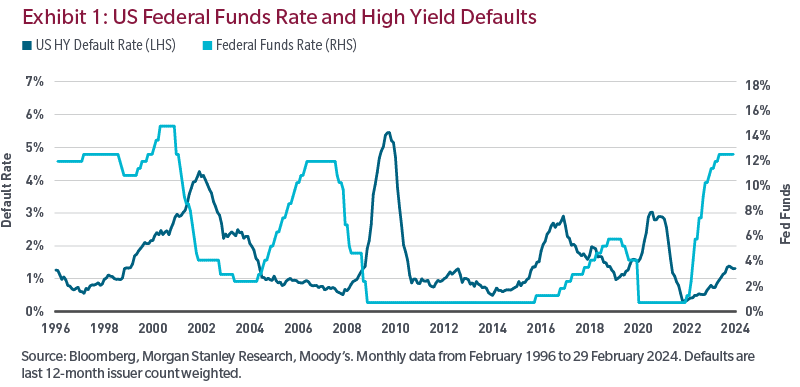Overall, while interest costs are expected to rise, we believe there are several factors that will help alleviate financial pressure put onto high yield issuers. Near-term maturities are only a small percentage of the overall index, and the number of distressed credits within that cohort are manageable. Companies have also been able to reduce debt levels, shore up balance sheets, and should continue to use inventive financing techniques like collateralized lending to reduce borrowing costs. These factors lead us to believe that high yield is well positioned to weather the higher interest rate environment and continue to deliver strong relative performance going forward.
Endnotes
1 Source: Moody’s, Trends global default report, March 2024.
2 Source: Bank of America Global Research. High Yield Strategy: Tear Down This Wall as of 22 March 2024.
Source: Bloomberg Index Services Limited. BLOOMBERG® is a trademark and service mark of Bloomberg Finance L.P. and its affi liates (collectively “Bloomberg”). Bloomberg or Bloomberg’s licensors own all proprietary rights in the Bloomberg Indices. Bloomberg neither approves or endorses this material or guarantees the accuracy or completeness of any information herein, or makes any warranty, express or implied, as to the results to be obtained therefrom and, to the maximum extent allowed by law, neither shall have any liability or responsibility for injury or damages arising in connection therewith.
Information has been obtained from sources believed to be reliable, but J.P. Morgan does not warrant its completeness or accuracy. The Index is used with permission. The Index may not be copied, used, or distributed without J.P. Morgan’s prior written approval. Copyright 2022, J.P. Morgan Chase & Co. All rights reserved.
Source ICE Data Indices, LLC (“ICE Data”), is used with permission. ICE Data, its affiliates and their respective third party suppliers disclaim any and all warranties and representations, express and/or implied, including any warranties of merchantability or fitness for a particular purpose or use, including the indices, index data and any data included in, related to, or derived therefrom. Neither ICE Data, its affiliates nor their respective third party suppliers shall be subject to any damages or liability with respect the adequacy, accuracy, timeliness or completeness of the indices or the index data or any component thereof, and the indices and the index data and all components thereof are provided on an “as is” basis and your use is at your own risk. ICE Data, its affiliates and their respective third party suppliers do not sponsor, endorse or recommend MFS, or any of its products or services.
The views expressed herein are those of the MFS Investment Solutions Group within the MFS distribution unit and may differ from those of MFS portfolio managers and research analysts. These views are subject to change at any time and should not be construed as the Advisor's investment advice, as securities recommendations, or as an indication of trading intent on behalf of MFS.








